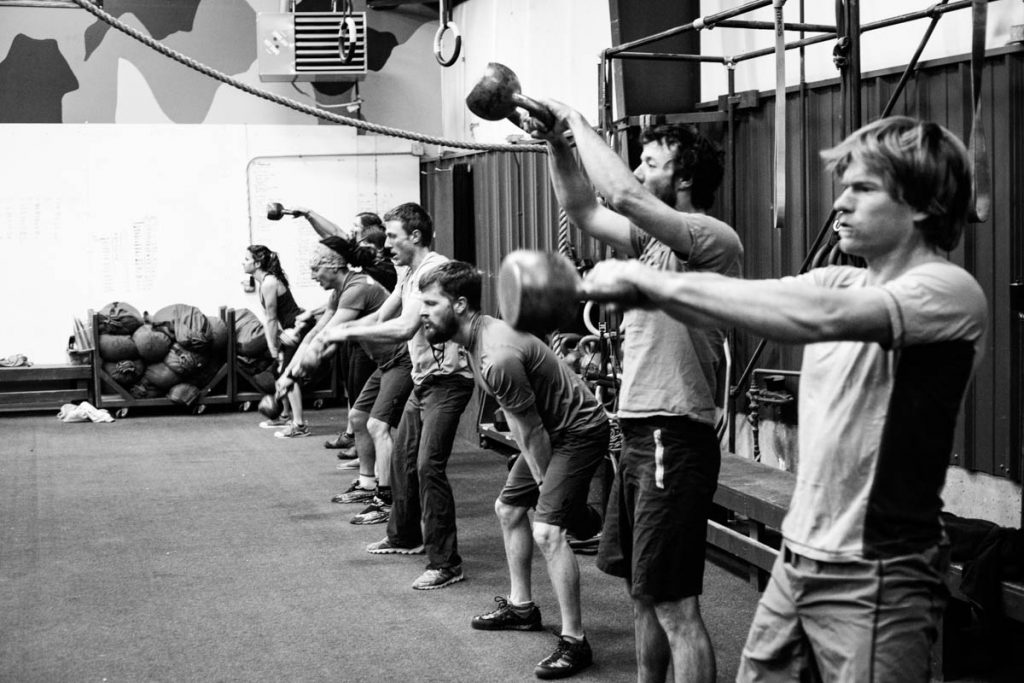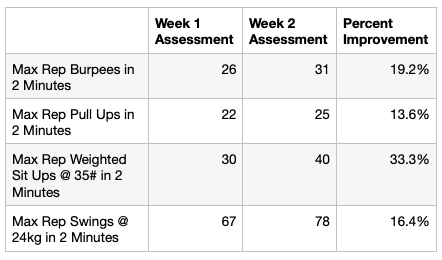
By Rob Shaul
The “2/3-30-6” progression method for rep-based assessments is a proven and handy progression tool I use at MTI across multiple training plans and mission sets.
I personally just finished a 3.5 week, assessment-based training cycle and used the “2/3-30-6” tool to solid effect. Once every three days I trained strength and my sets and reps were based on a repetition-based assessment I took on day one. Below was the assessment I took:
(1) Max Rep Burpees in 2 Minutes
(2) Max Rep Strict Pull Ups in 2 Minutes (release the bar and rest as needed)
(3) Max Rep Weighted Sit Ups @ 35# in 2 Minutes
(4) Max Rep Kettlebell Swings at 24kg in 2 Minutes
“2/3-30-6” applies to:
- Density Progression time interval – 2/3 of the assessment time
- First Progression Reps – 30% of Max Reps from the assessment
- Number of sets or rounds – 6
After the assessment but beginning with the assessment training sessions, the follow-on training session(s) “working rounds” deploy the 2/3-30-6 method.
Below was the Assessment Training Session:
Warm Up:
4 Rounds
-
- 10x Squats
- 10x Push Ups
- 10x Sit Ups
- Instep Stretch
- Lat + Pec Strength
Training:
(1) Max Rep Burpees in 2 Minutes
(2) Max Rep Strict Pull Ups in 2 Minutes (release the bar and rest as needed)
(3) Max Rep Weighted Sit Ups @ 35# in 2 Minutes
(4) Max Rep Kettlebell Swings at 24kg in 2 Minutes
RECORD ALL RESULTS
(5) 3 Rounds, every 80 Seconds …
-
- 30% Max Rep Burpees
80 seconds is 2/3 the assessment time of 120 seconds. I begin the progression with 30% of my max reps, and do 3 sets or rounds in this initial training session, and 6 sets or rounds for the follow on sessions. On the initial assessment I scored 26 burpees in 2 minutes. 26 x .3 = 7.8 or 8x (round up). So, set a repeating interval countdown timer to 80 seconds and on “go” complete 8x burpees as fast as possible. The faster you finish, the more rest you get before round 2 begins. Continue until you’ve completed 3 Rounds. Use the same method to calculate reps for the remaining exercises.
(6) 6 Rounds, every 80 Seconds …
-
- 30% Max Rep Pull Ups
(7) 6 Rounds, every 80 Seconds …
-
- 30% Max Weighted Sit Ups @ 35#
(8) 6 Rounds, every 80 Seconds …
-
- 30% Max Rep Swings
**Rest as needed between exercises.
Here was my next strength training session:
Warm Up:
4 Rounds
-
- 10x Squats
- 10x Push Ups
- 10x Sit Ups
- Instep Stretch
- Lat + Pec Strength
Training:
(1) 6 Rounds, every 80 Seconds …
-
- 30% Max Rep Burpees
(2) 6 Rounds, every 80 Seconds …
-
- 30% Max Rep Pull Ups
(3) 6 Rounds, every 80 Seconds …
-
- 30% Max Weighted Sit Ups @ 35#
(4) 6 Rounds, every 80 Seconds …
-
- 30% Max Rep Swings
**Rest as needed between exercises.
Progression Details
The progression steps increase in 5% intervals, so 30% max reps steps 35% max reps which steps to 40% max reps which steps to 45% max reps.. Complete each progression level twice except for 45% – which you’ll complete once. Then re-assess and reset the progressions – if you want to continue improving in these areas.
Below is the simple calendar I used for this training cycle. I trained six days/week, with Sunday’s off.

The beauty of this progression is it’s simplicity, universality and how it automatically scales to the incoming fitness of each individual athlete.
I will say at the 45% progression level, the 2/3 density interval time can become tight. In my case, I found I had to increase the interval time to 90 seconds for the swings to account for rapidly loosing grip strength – and ensure I got a few seconds rest between rounds and could complete the reps unbroken.
This generally only occurs at the 45% progression level, and only for certain athletes and exercises. I’ve seen it mostly for push ups. In my case, I was able to stick with the 80 second density interval for the pull ups, weighted sit ups and burpees, but again, had to increase the interval to 90 seconds for the swings because of grip strength..
Rarely have I not seen re-assessment improvement following this protocol. And, on the times it does happen, I can usually attribute it to an “off” day for the athlete because of fatigue, lack of sleep, sickness, etc. In my case, I improved my assessment scores for each exercise. In general, I expect to see 10-20% improvement, depending on the athlete, for the second assessment. The less fit athletes will see more improvement. The more fit athletes will see less improvement. See my assessment and re-assessment scores below:

If I wanted to continue with these exercises, I would re-set the progression and begin with 30% max reps based on the Re-Assessment numbers.
Applicability
Over the past nearly 20 years, I’ve seen the 2/3-30-6, or similar, progression work across multiple strength andwork capacity rep-based exercise assessments. We’ve most frequently applied it to bodyweight strength assessments and if you’ve ever completed one of MTI’s fitness test training plans, you’ve experienced this before.
But the 2/3-30-6 progression methodology can also be applied to loaded efforts like I did here with swings and weighted sit ups.
I’ve applied it as well to efforts like box jumps, shuttle sprints and sandbag get ups and max rep dead lifts @ 225#.
I’ve also applied it to longer and shorter durations – as short as 60 seconds and up to 12 minutes.
It’s a great tool for any coach to use in his or her programming, as well as any athlete who’s begun to program for themselves or is stuck in a motel, or someplace remote for 2-3 weeks and needs a way to program strength and work capacity. The 2/3-30-6 methodology allows a proven progression to used for any limited equipment situation.
I expect to see a 10-20% assessment improvement after the first iteration, and a 1-10% improvement after the second. Most the gains the athlete achieves will after the first full progression (2 sessions each at 35, 40 and 45% max reps). Expect more improvement from less fit athletes, and less improvement from more fit athletes.
Questions/Comments?
Ask below or email rob@mtntactical.com.
